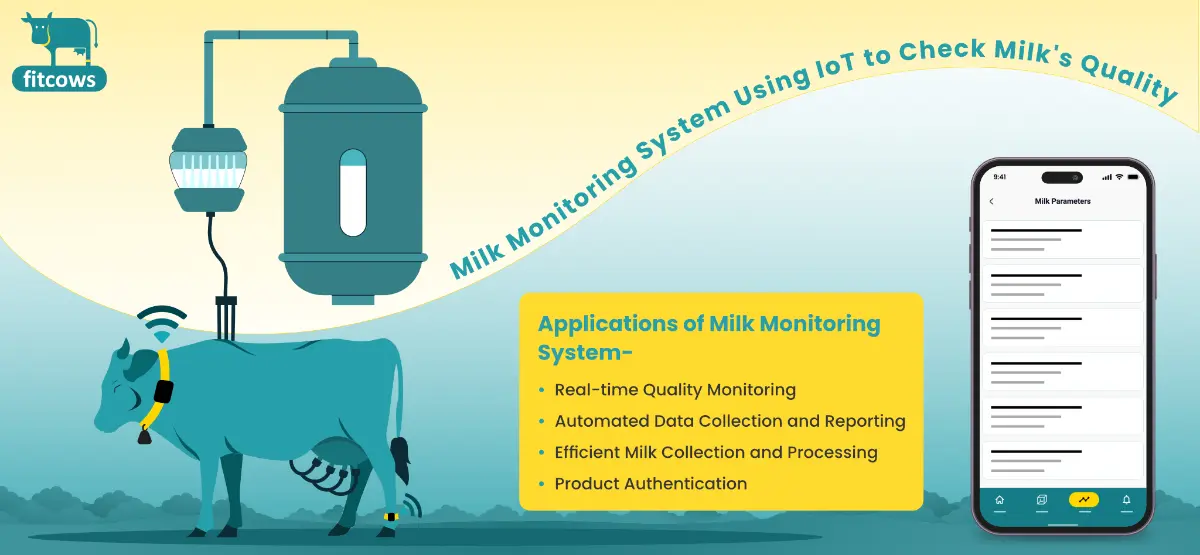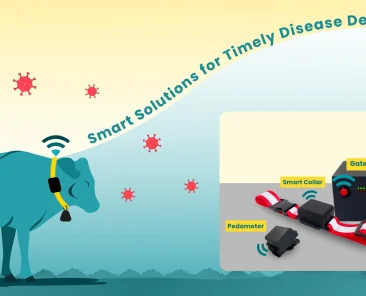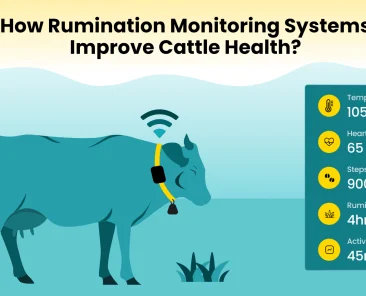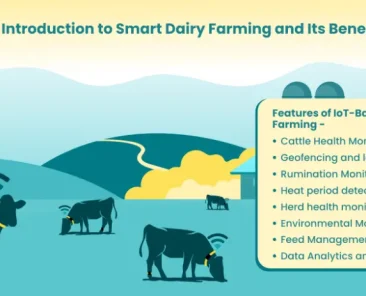Taking care of cattle health is important for any farm’s success. However, diseases like foot-and-mouth, mastitis, and tuberculosis can seriously affect the animals and productivity. Disease detection in cattle is…
- Home
- Cow Health Monitoring
- Milk Monitoring System Using IoT to Check Milk’s Quality
Milk Monitoring System Using IoT to Check Milk’s Quality
- Categories: Cow Health Monitoring
Get in Touch
Related Blogs
The use of smart technology has transformed the management of animal health. Farmers can keep an eye on animal activity in real-time with livestock monitoring, especially through rumination tracking, which…
Dairy farming is an important aspect of agriculture, and “smart dairy farming” might sound like an oxymoron, but it is a reality now. Large dairy farms with more than 100…
This blog aims to explain how a smart cattle monitoring system assists in successful artificial insemination in cattle. Artificial insemination is a practice followed by dairy farms to achieve higher…
Milk is a primary source of nutrition and there are more than 11 billion consumers of milk throughout the world.
No matter how popular soy and almond milk have become, India still has the highest number of milk consumers.
Being a country with higher milk consumers, we are also a country with high milk production.
However, distributing milk in every region can become a little unorganized if not handled properly. Plus, the nutrition level of milk should also be up to the mark.
That is why milk quality analysis is important before it is retailed.
The milk monitoring system using IoT makes milk quality assessment more accurate and cost-effective. This IoT-based milk monitoring system can help farmers test milk parameters directly after milking.
So, let’s learn how a milk monitoring system using IoT works and why it is important.
Why There is a Need to Analyse Milk?
Milk is a perishable product. It means it can easily be spoiled if it’s not handled and distributed locally within a couple of hours of being gathered.
To avoid such instances there is a need for a real-time monitoring system that can keep an eye on the quality of the milk.
Milk quality analysis is also important to assess the physical, chemical, and microbiological characteristics of milk.
Nevertheless, the parameters analyzed to maintain proper milk quality are milk fat content, protein content, somatic cell count, bacterial count, and antibiotic residues. Also remember that the milk fat content can vary depending on the species of the cattle, their diet, and genetics.
Whereas, somatic cell count indicates udder infection and bacterial counts indicate hygiene during milking and storage. As this can affect the shelf life of the milk.
Thus, milk quality analysis ensures the safety and suitability of the milk for consumption.
Explain Milk Monitoring System Using IoT.
The smart IoT-based milk monitoring system works by integrating multiple sensors that work as the brain of the system and collect information based on milk quality.
To state clearly, the system includes several sensors such as pH sensors that measure the acidity or alkalinity of the milk, an LDR system for fat content analysis, and a heat index sensor to measure the combined effect of temperature and humidity.
This milk monitoring system using IoT continuously monitors various parameters crucial to milk quality.
These sensors are integrated into the milk production and transportation process, providing real-time data transmitted to a centralized database or cloud platform. The collected data is processed and analyzed using machine learning algorithms and data analytics techniques to assess milk quality. This makes it possible to identify and validate any anomalies or deviations, allowing for the proactive maintenance of quality standards through preventative procedures.
The following benefits are achieved through integrating milk monitoring systems using IoT in traditional dairy farm practices:
- To ensure that milk meets nutritional requirements.
- Milk safety is ensured by identifying potential hazards.
- To build consumer confidence
- Assessing quality in order to comply with regulations and standards.
Applications of Milk Monitoring System

A milk monitoring system using IoT offers numerous applications that revolutionize dairy farming and milk quality management. Below are mentioned some of its applications:
Real-Time Quality Monitoring
IoT sensors continuously measure milk parameters such as temperature, pH, fat content, protein levels, and lactose concentration. This real-time monitoring ensures that any deviations from the required standards are promptly detected, maintaining high-quality milk.
Automated Data Collection and Reporting
IoT devices automate the collection of milk data, reducing the need for manual sampling and recording. This data can be instantly transmitted to central systems for analysis and reporting, ensuring accurate and timely information on milk quality.
Efficient Milk Collection and Processing
By providing real-time data on milk quantity and quality, IoT systems enable more efficient planning and logistics for milk collection and processing. This helps reduce wastage and optimize resource utilization.
Product Authentication
The smart milk monitoring system using IoT can also be utilized to verify the purity of milk products by comparing the analyzed parameters with established standards. This is also useful in detecting adulteration and dilution of milk.
To Sum Up,
Fitcows cow health monitoring system offers comprehensive milk monitoring by providing real-time data and a user-friendly interface for informed decision-making.
We at Fitcows have developed and designed smart livestock monitoring devices to provide practical applications to dairy farms.
Contact us or request a demo and experience the working of our smart cattle monitoring solution by yourself.
FAQs
What is a milk monitoring system?
A milk monitoring system using IoT tracks and monitors milk quality and production on dairy farms. It measures parameters like temperature, pH, and fat content, ensuring optimal storage and hygiene. This helps maintain milk quality, enhance productivity, and meet regulatory standards.
How IoT is used in milk production?
In the process of milk production, IoT is utilized to monitor cow health, track milk yield, detect heat period for successful AI, and manage feeding. Fitcows smart neck collar and pedometers are embedded with sensors that collect data on temperature, pH, and milk quality, enabling real-time analysis, improving efficiency, and ensuring better milk quality and farm management.
What are the benefits of using IoT in milk monitoring?
Using IoT technology in milk monitoring improves milk quality by monitoring temperature and pH in real-time, reduces waste by detecting issues early, optimizes storage conditions, improves animal health monitoring, and increases profit for dairy farms.
Get in Touch
Related Blogs
Taking care of cattle health is important for any farm’s success. However, diseases like foot-and-mouth, mastitis, and tuberculosis can seriously affect the animals and productivity. Disease detection in cattle is…
The use of smart technology has transformed the management of animal health. Farmers can keep an eye on animal activity in real-time with livestock monitoring, especially through rumination tracking, which…
Dairy farming is an important aspect of agriculture, and “smart dairy farming” might sound like an oxymoron, but it is a reality now. Large dairy farms with more than 100…
This blog aims to explain how a smart cattle monitoring system assists in successful artificial insemination in cattle. Artificial insemination is a practice followed by dairy farms to achieve higher…




